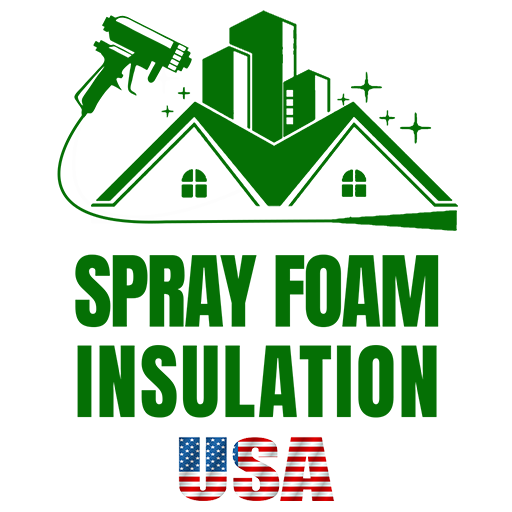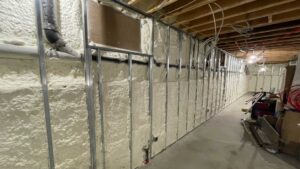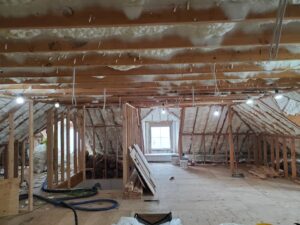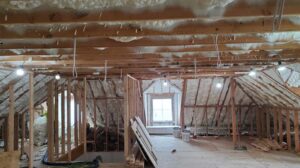Introduction
When considering insulated metal panels residential, homeowners and business owners find an appealing solution that balances durability, aesthetic versatility, and exceptional energy efficiency. These panels are not just for commercial spaces; they offer numerous benefits that make them ideal for residential applications as well.
Insulated metal panels (IMPs) are composite elements consisting of an insulating layer sandwiched between two metal skins. They are celebrated for their quick and easy installation and their superior thermal performance, making your home or business not only more energy-efficient but also reducing heating and cooling costs significantly.
In terms of design, these panels provide a modern look with a wide array of colors, finishes, and profiles, allowing customization to fit any architectural style or preference. Whether you’re renovating or building from scratch, IMPs can be tailored to meet specific design needs, making them a flexible choice for any project.
For those exploring eco-friendly and energy-saving options in NY and NJ, insulated metal panels offer a smart choice. They contribute to a greener planet by enhancing building envelope performance, minimizing environmental impact.

With the rise in energy costs and the growing emphasis on sustainability, choosing the right materials for your home is more crucial than ever. Insulated metal panels stand out as a superior option that meets the needs of today’s environmentally conscious and cost-efficient consumer.
Benefits of Insulated Metal Panels for Residential Use
When considering materials for your home, choose ones that will stand the test of time and offer multiple benefits. Insulated metal panels residential usage ticks all these boxes. Here’s why:
Durability
Insulated metal panels are incredibly robust. Their metal exterior can withstand severe weather conditions, from heavy snow to strong winds and hail. Unlike traditional building materials that might degrade over time due to environmental factors, these panels maintain their integrity for decades.
Safety
Safety is a paramount concern in any home. Insulated metal panels offer superior fire resistance. Their non-combustible materials help contain flames and limit fire damage, which is crucial in protecting both the structure of your home and its occupants.
Energy Efficiency
One of the standout features of insulated metal panels is their energy efficiency. The panels are designed with a core that significantly reduces heat transfer, helping maintain a comfortable indoor temperature regardless of the weather outside. This thermal resistance means your heating and cooling systems don’t have to work as hard, leading to lower energy consumption and reduced utility bills.
Cost Savings
The initial installation of insulated metal panels might seem like an investment, but it’s one that pays off in the long run. Their ease of installation and minimal maintenance requirements reduce overall construction and upkeep costs. Additionally, the energy efficiency of the panels can lead to significant savings on heating and cooling expenses.
Aesthetic Variety
Whether you prefer a modern or traditional look, insulated metal panels come in various colors, thicknesses, and profiles, allowing for a high degree of customization. This versatility means you can achieve almost any aesthetic you desire without compromising on performance.
Low Maintenance
Unlike other materials that require regular painting, sealing, or repairs, insulated metal panels are low maintenance. Their durability means they retain their appearance and function over time with little upkeep, freeing you from the burden of frequent home maintenance tasks.
In summary, insulated metal panels offer a combination of durability, safety, energy efficiency, cost savings, aesthetic variety, and low maintenance, making them an excellent choice for residential construction. These panels not only meet the practical needs of a home but also contribute to a more sustainable and cost-effective future.
Understanding the Cost
When considering insulated metal panels residential for your home, grasp the financial aspects thoroughly. This section will cover the Price Range, Factors Influencing Cost, and Long-term Savings associated with insulated metal panels.
Price Range
The cost of insulated metal panels can vary significantly based on several factors including material specifications, size of the project, and customization options. Generally, prices might range from $7 to $12 per square foot. However, for specific projects, especially those requiring customized solutions, costs can be higher.
Factors Influencing Cost
Several elements can affect the overall cost of installing insulated metal panels:
- Material Costs: The type of metal and insulation used can influence the price. Higher quality materials typically cost more but offer better durability and insulation.
- Labor Costs: Installation of insulated metal panels is quicker than traditional construction methods, which can save on labor costs. However, the expertise required for installation means that labor isn’t cheap.
- Project Complexity: Custom cuts, unusual shapes, or additional features like integrated windows or doors can add to the cost.
- Transportation and Handling: The cost to transport these panels to your site and the equipment needed to handle them during installation can also impact the overall price.
Long-term Savings
While the upfront cost of insulated metal panels might be higher than traditional materials, the long-term savings can be substantial. These savings come from:
- Energy Efficiency: Insulated metal panels have excellent R-values, meaning they provide significant resistance to heat flow. This insulation efficiency can drastically reduce heating and cooling costs, offering ongoing savings on utility bills.
- Durability: These panels are highly durable and resistant to weather, pests, and fire, which reduces the need for costly repairs and maintenance.
- Speed of Construction: The faster installation time also means reduced labor costs and quicker occupancy, which can be particularly beneficial in commercial settings.
In conclusion, while the initial investment in insulated metal panels might be higher, the long-term benefits and cost savings they provide make them a financially sensible choice for residential construction. The next section will explore the simplified installation process, further highlighting how these panels can save time and money during construction.
Installation Process Simplified
Installing insulated metal panels residential systems is straightforward and efficient, making it a preferred choice for many homeowners and contractors. Let’s break down the key aspects of the installation process:
One-step Application
Insulated metal panels come pre-assembled with an insulation core sandwiched between two metal skins. This integrated structure allows for a one-step installation process. Unlike traditional construction materials that require multiple steps to install insulation and exterior finishes separately, these panels are ready to mount directly onto the building framework. This simplicity significantly speeds up the construction timeline.
Time Efficiency
Time is a critical factor in construction. With insulated metal panels, the installation process is remarkably fast. These panels are designed to cover large areas quickly and can be easily cut to size on-site, reducing the time spent on adjustments and modifications. The rapid installation not only saves time but also minimizes the exposure of building materials to potential weather-related damages during construction.
Cost Efficiency
The swift and straightforward installation of insulated metal panels leads to direct cost savings. By reducing the time needed for installation, the overall labor costs are lowered significantly. Additionally, the minimized construction timeline can reduce the costs associated with site management and security. Homeowners benefit from these savings and can redirect their budget towards other aspects of their home construction or design.
Professional Installation
While the installation of insulated metal panels is less complex than traditional materials, it is recommended to have them installed by professionals. Skilled installers can ensure that the panels are properly aligned, sealed, and secured, maximizing the performance of the insulation and the overall durability of the structure. Professional installation guarantees that all aspects of the panel system function optimally, from thermal resistance to moisture control.
In this section, we’ve seen how the simplified installation process of insulated metal panels not only saves time but also reduces costs significantly. Moving forward, we’ll explore the diverse design and aesthetic options available with these panels, which allow homeowners to achieve both functionality and style in their residential constructions.
Design and Aesthetic Options
When choosing insulated metal panels for residential use, homeowners are often pleasantly surprised by the vast array of design and aesthetic options available. These panels combine functionality with style, offering choices that can complement any home design.
Color Variety
One of the most appealing aspects of insulated metal panels is the extensive color palette. Gone are the days of limited color options; today, homeowners can select from a spectrum of colors ranging from subtle earth tones to vibrant hues. This variety ensures that the exterior of any home can be as unique and personalized as the interior.
Thickness and Profiles
Insulated metal panels come in various thicknesses and profiles, providing flexibility in design and application. Common thicknesses include 2”, 2 1/2”, 3”, and 4”, each offering different levels of insulation and structural strength. Profiles can vary from flat and sleek to ribbed or textured, allowing for further customization of the building’s appearance. This variety can significantly impact the aesthetic appeal and the energy efficiency of the home.
Customizability
The adaptability of insulated metal panels extends beyond color and profile. The dimensions of the panels can be tailored to specific needs, making it possible to achieve a seamless look even on complex architectural designs. Whether it’s a modern minimalist home or a more traditional structure, these panels can be customized to enhance the overall design.
Visualizer Tools
To aid in the selection process, many manufacturers offer advanced visualizer tools. These digital tools allow you to upload a photo of your home and experiment with different panel options, seeing how various colors and styles will look on your actual residence. This can be an invaluable resource in making a final decision that you will be satisfied with for years to come.

The combination of these design and aesthetic options with the robust functionality of insulated metal panels makes them an excellent choice for any homeowner looking to upgrade their home’s exterior. Not only do these panels provide superior insulation and durability, but they also offer the flexibility to create a visually appealing home that stands out in the neighborhood.
We’ll delve into the technical specifications and performance features of these panels, which further justify their growing popularity in residential construction.
Technical Specifications and Performance
When considering insulated metal panels for residential use, understanding their technical specifications and performance is crucial. Here, we’ll explore key aspects like R-value, thickness range, thermal expansion, structural integrity, and fire resistance.
R-value
The R-value measures how well insulation can resist heat flow. Higher R-values mean better insulation and more energy efficiency. Insulated metal panels typically offer R-values ranging from 16 to 32, depending on the thickness of the panel. This makes them highly effective in maintaining indoor temperatures and reducing energy costs.
Thickness Range
Insulated metal panels are available in various thicknesses, typically from 2 inches to 4 inches. This range allows for flexibility in design and insulation needs, making it easier to meet specific energy efficiency requirements or architectural styles.
Thermal Expansion
Metal panels expand and contract with temperature changes. However, the design of insulated metal panels accommodates this thermal expansion through specific joint configurations, like the offset tongue-and-groove design. This helps maintain structural integrity and airtightness, preventing leaks and drafts.
Structural Integrity
These panels are not only great insulators but also add to the structural strength of your home. They are designed to withstand severe weather conditions, thanks to their durable metal facings and robust core materials. The 26-gauge galvanized steel, commonly used in these panels, ensures long-lasting performance and resistance to external impacts.
Fire Resistance
Safety is paramount in residential settings. Insulated metal panels like ThermalSafe® are designed to be fire-resistant. These panels can achieve a fire rating of up to three hours for walls and 1.5 hours for ceilings, offering peace of mind by enhancing your home’s safety against fire hazards.
Specific Products
- ThermalSafe®: This panel is specifically designed for fire resistance, making it an ideal choice for safety-conscious homeowners.
- Tuff Wall®: Offers a stucco-embossed finish for aesthetic appeal while maintaining durability and impact resistance.
- Tuff-Cast™: Mimics the appearance of precast concrete with the benefits of insulated metal panels, providing both aesthetic appeal and robust protection.
Incorporating these technical specifications and performance features into your home’s design not only optimizes energy efficiency but also enhances safety and durability. We will address some common questions about insulated metal panels to help you better understand their benefits and applications.
Frequently Asked Questions about Insulated Metal Panels
What are the disadvantages of insulated metal panels?
While insulated metal panels residential offer several advantages, there are a few considerations to keep in mind:
- Initial Cost: The upfront cost can be higher than traditional materials. Although this is often offset by long-term energy savings and durability.
- Design Limitations: While there is a variety of designs and finishes, the panels do have some limitations in terms of structural design flexibility compared to materials like wood or brick.
- Perception: Some homeowners may prefer the traditional look of other materials like wood siding or brick, which can be a subjective disadvantage.
How much does insulated metal panel cost per square foot?
The cost of insulated metal panels can vary widely depending on several factors such as the thickness of the panels, the type of coating, and the overall quality of the materials. Generally, you can expect to pay between $7 to $12 per square foot. This price includes both the cost of the panels and installation. It’s important to consider that while the initial expense might be higher, the long-term savings on energy bills and maintenance can be significant.
What is the R-value of insulated metal wall panels?
The R-value, which measures the material’s ability to resist heat flow, is a crucial factor in the effectiveness of insulation. Insulated metal panels typically have R-values ranging from R-16 to R-32, depending on the thickness of the insulation. For example, panels with a thickness of 2 inches generally have an R-value of 16, while those that are 4 inches thick can reach R-values of 32. This high insulating value makes insulated metal panels an excellent choice for energy-efficient home construction.
Moving forward, understanding these aspects of insulated metal panels can help homeowners and builders make informed decisions about incorporating this material into residential projects.
Conclusion
As we wrap up our discussion on insulated metal panels residential, it’s clear that these materials represent not just a step forward in building technology, but a leap toward a more sustainable and efficient future in residential construction.
Sustainability is at the core of why we advocate for the use of insulated metal panels in homes. These panels are not only durable but also have exceptional thermal properties that reduce the need for excessive heating and cooling, cutting down on energy consumption. This makes insulated metal panels an excellent choice for anyone looking to reduce their carbon footprint and contribute to a healthier planet.
Looking ahead, the future of residential construction is bright with innovations like insulated metal panels. As energy costs continue to rise and environmental concerns become more urgent, the demand for efficient, sustainable building solutions will only increase. Insulated metal panels offer a versatile and effective response to these challenges, providing superior insulation and a range of aesthetic options while being easy to install and maintain.
At Spray Foam Insulation USA, we are committed to leading the charge toward a more sustainable future. Our focus on advanced insulation solutions, including insulated metal panels, positions us to meet the evolving needs of modern homeowners. We believe that investing in these technologies not only makes sense for today’s construction needs but paves the way for a greener, more sustainable tomorrow.
In conclusion, as we continue to face global challenges related to energy and the environment, the choices we make in how we build our homes will have profound impacts. By choosing insulated metal panels, you’re opting for a product that offers durability, efficiency, and sustainability — a truly smart choice for any forward-thinking homeowner.





